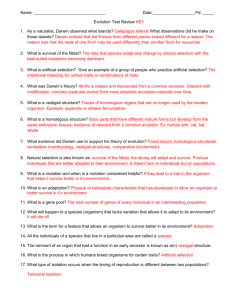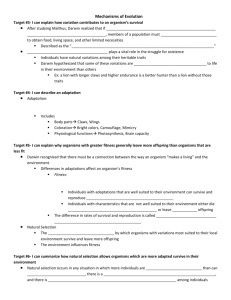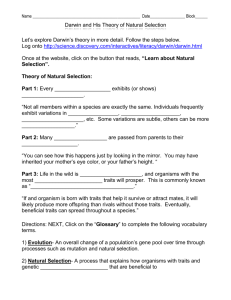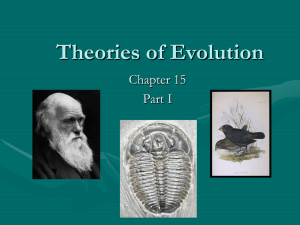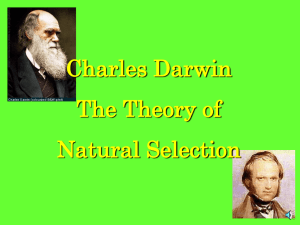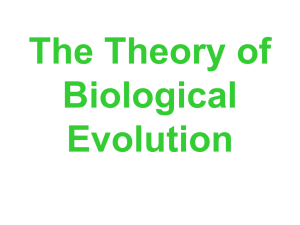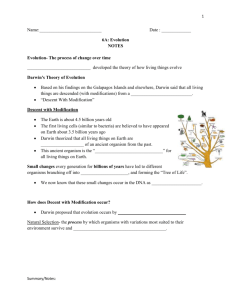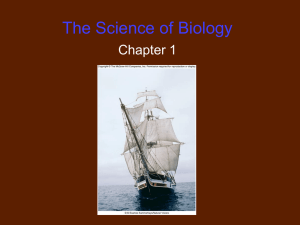Evolution and Natural Selection
advertisement
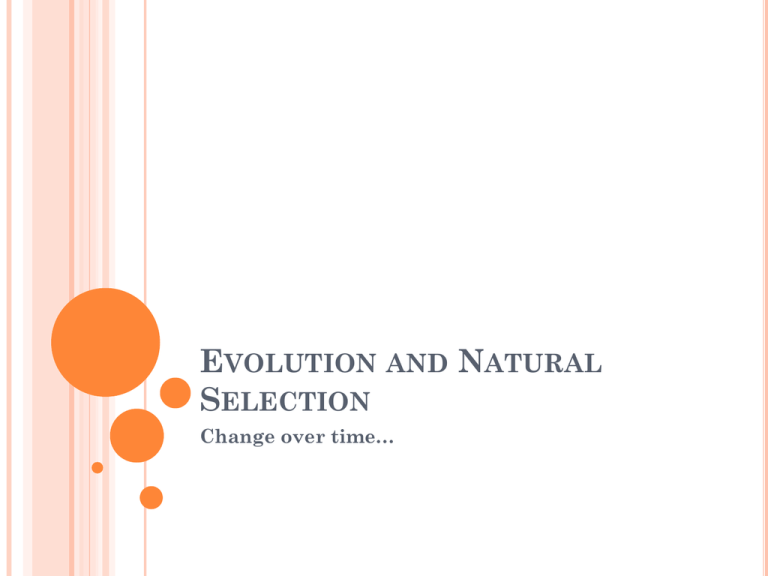
EVOLUTION AND NATURAL SELECTION Change over time… GEOLOGY Began to study rock layers called strata George Cuvier Studied fossils Found extinct species and noticed the deeper the fossil the more unique Catastrophism Charles Lyell Believed the earth to be millions of years old Uniformitarianism JEAN BAPTISTE LAMARCK In 1809, Lamarck proposed that organisms evolved into more and more complex forms through use and disuse and the inheritance of acquired characteristics Organism strived to improve, causing new body structures to develop and “unused” structures to disappear Used structures would pass on to the offspring This theory is NOT accepted today CHARLES DARWIN AND THE BEAGLE In 1831, at the young age of 21, Charles Darwin took a job as a naturalist on the British ship know as the H.M.S. Beagle On his five year journey Darwin studied and collected many different organisms When Darwin arrived at the Galapagos Islands, he was intrigued by the odd variety of species he saw there THE GALAPAGOS ISLANDS This small group of islands is home to many unique creatures, such as the giant tortoise, large marine iguanas, and flightless birds know as the cormorant In particular, Darwin noticed that there were many varieties of finches. Each variety was similar to the finches of the mainland of South America, yet adapted to its environment in a unique way. ADAPTATION – Any inherited characteristic or behavior that helps an organism better survive in its environment THE ORIGIN OF SPECIES When Darwin returned to England, he took his findings and compiled them into a book. It was not until another scientist, Alfred Wallace, approached him with his findings of how evolution worked that Darwin would publish his work. In 1859, Darwin published The Origins of Species, By Means of Natural Selection He stated that evolution occurred through natural selection. NATURAL SELECTION Darwin proposed that natural selection caused species to change 1) 2) 3) 4) Overproduction Organisms produce more offspring than can survive, Genetic Variation - There is variation Struggle to Survive - Some variations help the organism survive better in its environment. (Competition over food, mates, shelter, water, etc.) Differential Reproduction – Individuals with the best traits reproduce more. Over time more individuals will have the favored trait. Therefore, the population gradually changes, evolves, over time to better suit its environment. Survival of the fittest Fitness is a measure of an individual’s hereditary contribution to the next generation. ADAPTATIONS Fitness- a measure of an organisms contribution of viable offspring to the next generation Camouflage – adaptation that allows for blending in with the environment Mimicry – one species evolves to look like another species Antimicrobial resistance – “Super” bacteria; bacteria that are resistant to most antibiotics DO NOW Who is Lamarck? What did he do? What is an adaptation? Lamarck was one of the first scientist to proposed evolution. He believe that traits could be acquired throughout a life time and passed on to offspring. Anything that an organism did not use during that lifetime would be lost, hence his theory of acquired characteristics through use and disuse. Any inherited characteristic or behavior that helps an organism better survive in its environment What are the 4 aspects of natural selection? Over reproduction Variation among the species A struggle for survival – some are better suited than others and will survive to reproduce Inheritable traits meaning that the more favorable traits are passed on and begin to become a larger portion of the population EVIDENCE FOR EVOLUTION Darwin’s theory is supported by many different types of scientific evidence Fossils clearly show that many species have changed over time; some fossils show transitional forms (intermediate species between old and new species) Derived v. Ancestral Traits New traits v. old Feathers v. teeth EVIDENCE FOR EVOLUTION - STRUCTURES Homologous structures – many species with common ancestry show similar structures. Ex: forelimbs have similar bone structure Analogous Structures – unrelated species living in similar habitats often have similar structures. Ex: shark and dolphin fins/ bird and insect wings Vestigial Structures – a structure that no longer serves a purpose. Ex: appendix (humans) or pelvic bone (whales) COMPARATIVE EMBRYOLOGY AND GENETICS AND BIOGEOGRAPHY Genetic evidence – today, similarities in DNA and amino acid sequences show how species are related. Ex: humans and chimpanzees (our closest living relative) share over 90% of our DNA Embryology – vertebrates share similar characteristics at early stages of development Biogeography – the distribution of plants and animals effects how natural selection works on them PATTERNS OF EVOLUTION Isolation and natural selection can lead to different types of evolution Convergent evolution – distantly related organisms become more similar over time due to similar habitats Divergent evolution – one species eventually diverges into two or more species, becoming increasingly different over time in response to different environments Adaptive radiation Artificial Selection – Humans choose the traits that they want which leads to evolution as well Coevolution – when two interacting species evolve around each other (predator/prey; host/virus; plant/pollinator) ISOLATION Speciation often begins when two groups become isolated Two types of isolation Geographic isolation – a physical barrier separates 2 groups, such as a body of water, mountain range, highway etc. Reproductive isolation – occurs when 2 groups cannot reproduce together; sometimes caused by geographic isolation, but can also occur because of a change in behavior Prezygotic isolation Postzygotic isolation SPECIES The process of species formation is called speciation. For many years species were determined by morphology, the internal and external appearance of an organism. The morphological concept of species has limitations since individuals within a species can look different. The biological species concept says that a species is a population that can interbreed but cannot breed with other groups. Modern day definition states that a species is one that looks similar and allows for interbreeding to produce fertile offspring NON-RANDOM MATINGS Stabilizing selection is when the individuals with the average form of the trait have the highest fitness. Directional selection is when the individuals with a more extreme form of the trait have greater fitness than the average form of the trait. Disruptive selection is when the individuals with either form of the extreme trait have greater fitness than the average form of the trait. Sexual selection is when one mate has to chose the other based on certain characteristics. BIODIVERSITY Evolution usually leads increased biodiversity Increased biodiversity strengthens an ecosystem by increasing the “connections” in the food web and making it less susceptible to disease If species cannot evolve quickly enough, evolution may lead to extinction There have been 5 mass extinctions throughout history Are humans currently causing the next mass extinction?

